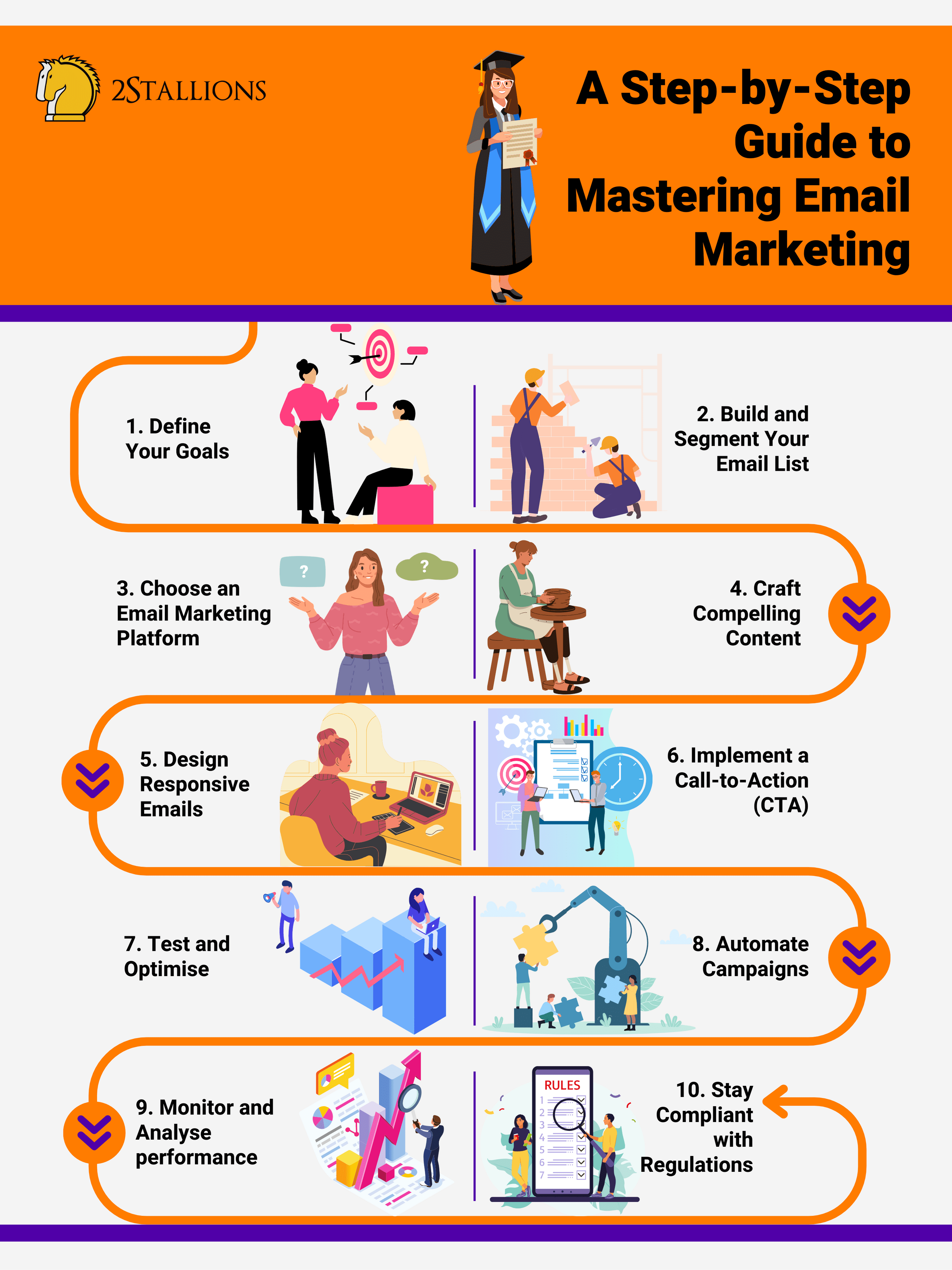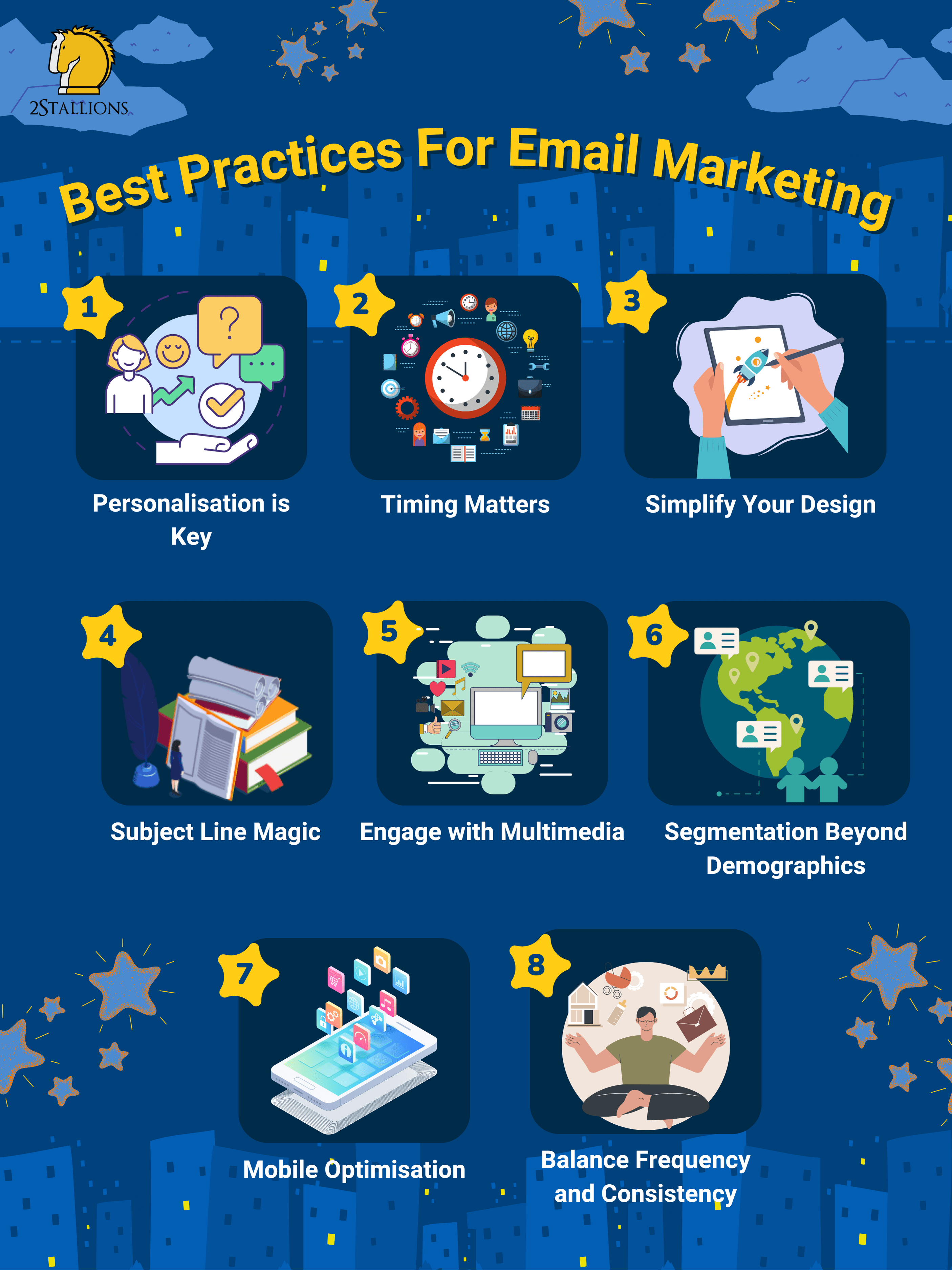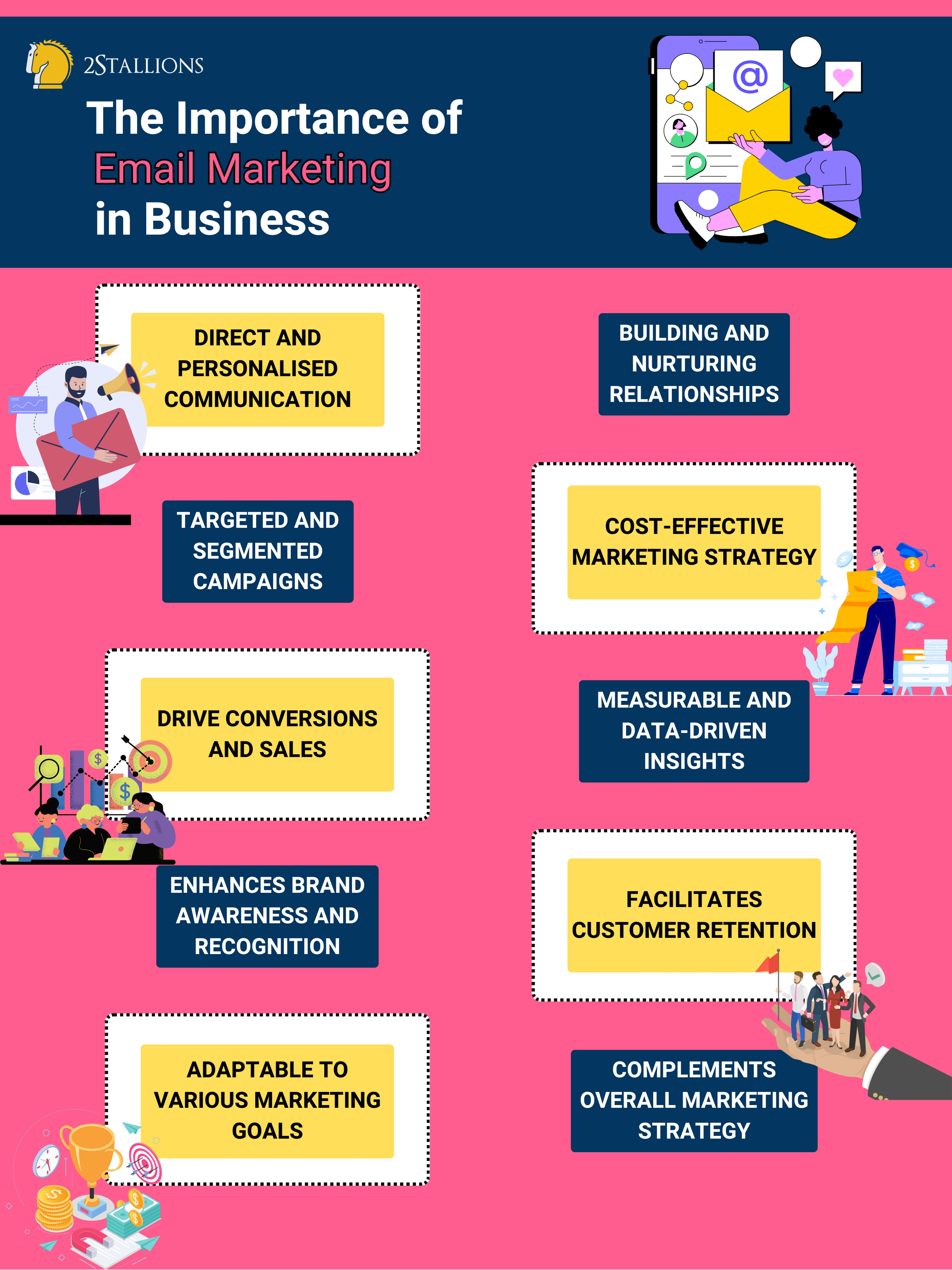SHARE

Despite being one of the oldest forms of digital communication, most people still rely on email for work-related and personal communication. Yes, there are newer communication methods – the world is awash with social media messengers and live chat platforms like Telegram and Whatsapp – yet email is still used by over 4 billion people.
The truth is that email marketing has been around for so long that it’s just not going to go out of style anytime soon. The benefits are endless, and you have instant access to your customers’ inboxes; with all the available channels, it’s still one of the most effective ways to reach potential consumers.
[thrive_leads id=’8305′]
Have you ever wondered how certain businesses captivate your attention, keep you engaged, and prompt you to act in the crowded digital marketing realm? Email marketing is a dynamic and resilient force that survives and thrives in the ever-evolving landscape of online promotion. Imagine an artful dance of words and visuals delivered straight to your inbox, tailored to your preferences—this is the essence of email marketing. It’s more than just messages; it’s a strategic conduit connecting businesses with their audience, irrespective of size.

A Step-by-Step Guide to Mastering Email Marketing
Embarking on a captivating journey into email marketing isn’t just about hitting “send” – it’s an art that demands strategic finesse, meticulous planning, and a profound understanding of your audience. Buckle up as we guide you through the intricate steps, revealing a roadmap to elevate and revolutionise your email marketing. Let’s venture together into a world where precision meets purpose.
1. Define Your Goals:
Begin your expedition by vividly outlining your objectives. Whether it’s nurturing leads, showcasing products, or boosting brand awareness, these goals will be the guiding stars shaping the content and structure of your email campaigns.
Example: Picture this – your goal is to nurture leads. Imagine crafting email campaigns that serve valuable information, educational content, and irresistible incentives, nudging those leads down the sales funnel.
2. Build and Segment Your Email List:
Cultivate a high-quality email list by enticing subscriptions through your website, social media, or other channels. Think of it as curating a dynamic guest list for an exclusive party, where segmentation based on demographics, behaviours, or preferences ensures a tailored and engaging experience.
Example: Imagine tempting website visitors with a free downloadable resource as the VIP pass. Now, segment that list based on location, purchase history, or interests. It’s like throwing a party where everyone feels right at home!
3. Choose an Email Marketing Platform:
Select a reliable email marketing platform that suits your needs. Think of it as choosing the perfect partner for a dance – options like Mailchimp, Constant Contact, or HubSpot come with user-friendly interfaces, analytics, and automation features, turning your email campaigns into a well-choreographed performance.
Example: Imagine selecting Mailchimp as your dance partner. Its user-friendly moves, analytics twirls, and automation spins make it a perfect match, especially for businesses seeking simplicity and effectiveness on the dance floor.
4. Craft Compelling Content:
Weave a narrative that resonates with your audience, creating a symphony of attention-grabbing subject lines, compelling copy, and visually stunning designs. Your message is the melody, offering value that’s not just informative or entertaining but akin to a backstage pass for exclusive promotions.
Example: Craft an email with a subject line that’s a head-turner, like “Unlock Exclusive Savings.” Picture the content as a harmonious blend of a compelling story, a limited-time offer, and visually enticing images – an irresistible melody that prompts recipients to take centre stage.
5. Design Responsive Emails:
In a world where screens come in all shapes and sizes, ensure your emails are responsive, a visual feast on every screen. Think of it like tailoring an outfit – a well-designed layout enhances the user experience, ensuring your audience enjoys the show, regardless of the device.
Example: Picture your email template as a bespoke suit that seamlessly adjusts to mobile screens, offering an optimal viewing experience. It’s like having a wardrobe that’s not just stylish but fits perfectly, enhancing engagement.
6. Implement a Call-to-Action (CTA):
Clearly define the steps you want recipients to take, like choreographing a dance routine. Whether purchasing, subscribing, or downloading content, a well-placed and enticing CTA is your spotlight moment for conversions.
Example: Imagine your goal is to drive sales – the CTA becomes the dance move, a button saying “Shop Now.” Strategically placed within the email, it stands out with vibrant colours and persuasive language, stealing the show.
7. Test and Optimise:
Regularly test different elements of your campaigns, a bit like refining dance steps. A/B testing becomes your rehearsal room, identifying what resonates best with your audience. Analyse performance metrics and refine your moves for a flawless performance like a seasoned dancer.
Example: Conduct A/B testing on two versions of an email – one with a humorous subject line and another with a straightforward one. Analyse the applause (open rates) to determine which resonates better and refine future campaigns for an encore.
8. Automate Campaigns:
Embrace automation to streamline your email marketing efforts, envisioning it as the backstage crew that ensures everything runs smoothly. Set up automated campaigns for welcome emails, drip campaigns, and follow-ups – it’s like having a team that anticipates and responds to every cue.
Example: Set up a welcome email series for new subscribers, introducing them to your brand. It’s like the automated backstage crew, gradually showcasing products or services, ensuring a seamless and engaging performance.
9. Monitor and Analyse performance:
Track key metrics like open rates, click-through rates, and conversion rates, akin to reviewing the critics’ response after a performance. Use analytics to understand what works and what needs improvement, adjusting your strategy based on these data-driven insights.
Example: Imagine tracking open rates, click-through rates, and conversion rates like reading reviews. If a particular type of content consistently gets a standing ovation, adjust your strategy to incorporate more of that content in future campaigns.
10. Stay Compliant with Regulations:
Familiarise yourself with email marketing regulations to ensure compliance – think of it as adhering to the rules of the stage. Obtain explicit consent from subscribers, provide clear opt-out options, and respect privacy laws like the code of conduct for a stellar performance.
Example: Include a clear opt-out link in every email – it’s like offering an emergency exit for those who need it. Ensure subscribers explicitly consent to receive emails – it’s like ensuring every audience member willingly buys a ticket to the show. Regularly update your practices to align with privacy laws, maintaining a reputation as a responsible performer in the email marketing arena.

Best Practices For Email Marketing
Is mastering the art of email marketing essential for businesses seeking to captivate their audience and drive meaningful engagement in the dynamic landscape of digital communication? In a competitive inbox, refining your approach becomes critical. Explore a transformative voyage with us to enhance your email marketing strategy, where we reveal a curated set of proven tips to elevate your campaigns, nurture stronger connections, and propel your success in online communication.
Personalisation is Key
Tailor your emails based on customer data. For instance, use the recipient’s name instead of a generic greeting. If your customer recently purchased a specific product, recommend complementary items or offer exclusive discounts related to their purchase history.
Timing Matters
Consider your audience’s habits and time zones. For instance, if you have an international audience, schedule emails to align with peak engagement hours in various regions. Experiment with different send times and analyse open rates to pinpoint the optimal timing for your audience.
Simplify Your Design
Opt for a minimalist design that conveys your message. Use concise and compelling copy complemented by visually appealing images. For example, a sleek design with a single, impactful image and a focused call-to-action can enhance the overall aesthetic.
Subject Line Magic
Craft intriguing subject lines that spark curiosity. For instance, instead of a generic “New Arrivals,” try “Unlock Exclusive Access to Our Newest Collection – Limited Time Only!” A compelling subject line entices recipients to open and explore your email.
Engage with Multimedia
Incorporate multimedia elements to capture attention. Include a product demonstration video, a visually striking infographic, or an animated GIF showcasing key features. Visual content enhances the overall appeal of your message and can convey information more effectively.
Segmentation Beyond Demographics
Dive deeper into segmentation based on behaviour. For instance, create segments for frequent purchasers, inactive subscribers, or those who abandoned their carts. Tailor content to re-engage each segment, such as offering a loyalty discount to regular buyers or a reminder for abandoned cart items.
Mobile Optimisation is Non-Negotiable
Ensure your emails are mobile-friendly. Use a responsive design that adapts to various screen sizes. Test your emails on different devices to guarantee a seamless experience. A well-optimised email ensures that your audience can engage with your content wherever they are.
Balance Frequency and Consistency
Find a rhythm that suits your audience. For example, if you run a weekly newsletter, maintain a consistent schedule to establish expectations. However, be mindful only to inundate subscribers with a few emails. Adjust the frequency based on audience feedback and engagement metrics.

The Importance of Email Marketing in Business
Step into business mastery, where one tool has proven its resilience as a true cornerstone: email marketing. This dynamic strategy isn’t just a valuable asset. It’s indispensable for companies striving to thrive in the fiercely competitive online landscape. Let’s dive into why email marketing stands tall as a game-changer.
Personalised Conversations Direct to Your Inbox
Imagine having a direct line of communication that cuts through the digital noise and lands right in your audience’s inbox. That’s the magic of email marketing. It goes beyond other platforms, offering a personalised touch that forges a genuine connection and sparks engagement.
Relationships That Flourish
At its heart, email marketing is a relationship builder. Through regular newsletters, updates, and exclusive offers, it’s not just about transactions—it’s about cultivating trust and loyalty. It transforms one-time customers into ardent advocates, breathing life into your brand.
Precision in Targeting
With advanced segmentation tools, your email campaigns become finely tuned instruments. Tailor your messages to specific audience segments based on preferences, behaviours, and needs. This customisation ensures higher engagement and conversion rates, hitting the bullseye every time.
Cost-Effective Brilliance
Think cost-effectiveness–think email marketing. Compared to traditional advertising methods, sending targeted emails incurs minimal costs. It’s a boon for businesses, especially smaller ones, offering a significant return on investment without breaking the bank.
Driving Forces for Conversions
Watch your business rise as email marketing becomes a driving force for conversions and sales. Crafted with finesse, emails featuring promotional offers, product announcements, or personalised recommendations prompt recipients to take action, translating into tangible results.
Data-Driven Excellence
Email marketing is not just a shot in the dark. It’s a data-driven powerhouse. Metrics like open rates, click-through rates, and conversion rates provide a goldmine of insights. This wealth of data allows businesses to refine and optimise their strategies for continuous improvement.
Brand Brilliance in Every Email
Consistency is key, especially in email campaigns. Meticulously crafted emails with branded visuals and messaging contribute significantly to brand awareness. Stay top-of-mind with your audience, reinforcing your brand identity and leaving an indelible mark.
Customer Retention Mastery
In the world of business, keeping existing customers is a triumph. Email marketing excels in customer retention. Regular updates, exclusive offers, and personalised content create a positive customer experience, fostering lasting loyalty.
Adaptable to Your Every Goal
Versatility is the name of the game for email marketing. Whether driving website traffic, promoting new products, or gathering feedback, it adapts effortlessly. This flexibility makes it a go-to tool, indispensable for achieving a spectrum of marketing objectives.
A Symphony in Marketing Strategies
Email marketing doesn’t dance solo; it’s part of a harmonious ensemble. Integrated with social media, content marketing, and various strategies, it becomes the cohesive force that elevates your overall marketing approach to new heights.
The Conclusion: Is Email Marketing still a ‘thing’?
The short answer is ‘yes, it’s still a thing’. It’s still a big thing! Yes, we know email isn’t a new technology. In 1971, it was one of the very first means of digital communication. Today, it’s used more than ever before. People still use email! When you think of the advantages that email marketing provides, it remains one of the quickest and easiest ways to reach your business goals, whether they be revenue growth, customer outreach, or raising brand awareness and engagement.
Rev up your marketing game! Our email marketing services create personalised, data-driven campaigns for high ROI. Let’s skyrocket your business to new heights!
Originally published: April 28 2022
Updated: 13 December 2023
Frequently Asked Questions about Email Marketing
What Is the Main Point Of Email Marketing?
The main point of email marketing is to establish and maintain direct communication with a target audience through the use of emails. It is a powerful tool for businesses to convey messages, share information, promote products or services, and foster relationships with their audience.
What Is Email Marketing, and Why Is It Beneficial?
Email marketing is a digital marketing strategy that involves sending targeted messages via email to a group of people. It is beneficial for several reasons: it allows businesses to communicate directly with their audience, build and nurture relationships, drive conversions, and achieve a high return on investment (ROI). The personalised nature of emails makes it an effective and cost-efficient method to engage customers.
What Is the Most Important Thing in Email Marketing?
The most important thing in email marketing is relevance. Tailoring content relevant to the recipient’s interests, preferences, and behaviours is crucial for engagement and success. Whether it’s personalised product recommendations, exclusive offers, or valuable information, ensuring that the content resonates with the audience enhances the effectiveness of email marketing.
What Is the Main Goal Of Email Marketing?
The main goal of email marketing is multifaceted, encompassing various objectives. Primarily, it aims to build and nurture relationships with the audience, fostering brand loyalty. Additionally, email marketing seeks to drive conversions, whether making a purchase, subscribing to a service, or engaging with content. Ultimately, the overarching goal is to create a direct and impactful channel of communication that delivers value to the business and its audience.





